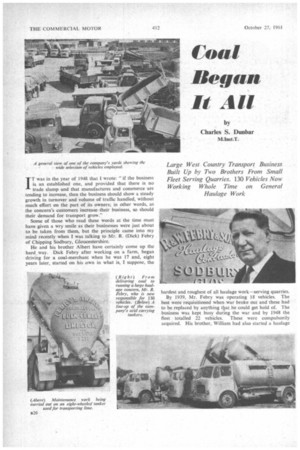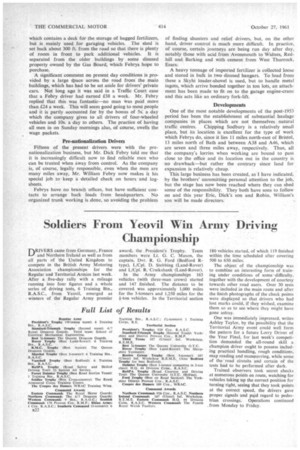Coal Began It All
Page 54

Page 55

Page 56

If you've noticed an error in this article please click here to report it so we can fix it.
by Charles S. Dunbar
M.Inst.T.
IT was in the year of 1948 that I wrote: "if the business is an established one, and provided that there is no trade slump and that manufactures and commerce are tending to increase, then the business should show a steady growth in turnover and volume of traffic handled, without much effort on the part of its owners; in other words, as the concern's customers increase, their business, so should their demand for transport grow."
Some of those who read these words at the time must have given a wry smile as their businesses were just about to be taken from them, but the principle came into my mind recently when I was talking to Mr. R. (Dick) Febry of Chipping Sodbury, Gloucestershire.
He and his brother Albert have certainly come up the hard way. Dick Febry after working on a farm, began driving for a coal-merchant when he was 17 and, eight years later, started on his own in what is, I suppose, the hardest and roughest of all haulage work—serving quarries.
By 1939, Mr. Febry was operating 18 vehicles. The best were requisitioned when war broke out and these had to be replaced by anything tat he could get hold of. The business was kept busy during the war and by 1948 the fleet totalled 22 vehicles. These were compulsorily acquired. His brother, William had also started a haulage business, which had grown to a strength of 10 vehicles, and these also were taken over.
Dick Febry did not confine his attention entirely to haulage and in 1938 he had three Leyland coaches. It was, therefore, natural that when he and his brother were deprived of their lorries, that they should go in for coaching and they acquired Streamways Coaches.
In those days there was a large R.A.F. camp at Yatesbury near Caine and the district in general was prosperous, so that they found plenty of work for the 20 vehicles they took oyer. At week-ends they had to hire a great number of coaches from other proprietors. Express services were run for Forces personnel and there. was a wide range of tours, including some to the Continent.
This burst of activity was relatively short-lived. The camp was closed, work fell off and when denationalization gave the opportunity to return to haulage, the brothers decided to reduce their passenger work and operated only three modern coaches. The goodwill of Streamways was sold _to G. D., G. and J. N. Keen of Heddington, near Devizes. The three _coaches could not cater for peak periods,•especially as licences were held for about 100 excursions and tours, and it was usual to hire eight or nine from other operators.
Another interim activity was the purchase of the old Yate Ironworks, making and repairing agricultural implements. Although this work is no longer done, the site has proved most useful in view of the rapid expansion of the fleet since 1954.
Now we come to the point of my quotation at the start of this article and let me say at once that 'l don't mean to imply that the Febrys have only had to sit back andwait for the business to flow in. Far from it! But when the brothers got going again in haulage, they were able by reason of their good pre-nationalization performance and their geographical position to obtain work from some of the most prominent 'concerns in quarrying, smelting and similar basic industries. As these concerns have grown in the boom conditions of recent years, so have R. and W. Febry.
There are now 130 vehicles in the fleet, some on contract, but the majority on open A licence. There are a few Fodens, but 90 per cent. are of Leyland make. Twentythree six-wheelers carry special bodies for ready-mixed concrete, eight eight-wheelers carry cement in tanks and another six carry acid. The remainder of the fleet consists of tippers and flats, many of which are articulated units.
The company's policy is not to expect vehicles to last for ever, in view of the tremendous amount of wear and tear. Average life is about five years, thus reducing maintenance. So far as possible, too, a driver always has the same vehicle and is responsible for it. Even so, a staff of 12, which includes body-builders, painters and a signwriter, does well to maintain such a fleet. Except for the special bodies for ready-mixed concrete the company makes all its own bodies, including metal units for the tippers. The garage is Manned all night and work goes on, too, at the week-ends. This cannot be avoided because of the high degree of vehicle use.
A recent addition to the premises at Chipping Sodbury has been the erection of a shed measuring 130. ft. by 95 ft., which contains a deck for the storage of bagged fertilizers, but is mainly used for garaging vehicles. The shed is set back about 300 ft. from the road so that there is plenty of room in front to park additional vehicles. It is separated from the older buildings by some disused property owned by the Gas Board, which Febrys hope to purchase.
A significant comment on present day conditions is provided by a large epace across the road from the main buildings, which has had to be set aside for drivers' private cars. Not long ago it was said in a Traffic Court case that a Febry driver had earned /38 a week. Mr. Febry replied that this was fantastic—no man was paid more than /24 a week. This will seem good going to most people and it is partly accounted for by the bonus of 5s. a day which the company gives to all drivers of four-wheeled vehicles and 10s. a day to others. The practice of having all men in on Sunday mornings also, of course, swells the wage packets.
Pre-nationalization Drivers
Fifteen of the present drivers were with the prenationalization business, but Mr. Dick Febry told me that it is increasingly difficult now to find reliable men who can be trusted when away from control. As the company is, of course, legally responsible, even when the men are many miles away, Mr. William Febry now makes it his special job to keep a detailed check on hours and logsheets.
Febrys have no branch offices, but have sufficient contacts to arrange back loads from headquarters. No organized trunk working is done, so avoiding the problem of finding shunters and relief drivers, but, on the other hand, driver control is much more difficult. In practice, of course, certain journeys are being run day after day, notably those with acid from Avonmouth to Widnes, Redhill and Barking and with cement from West Thurrock, Essex.
A heavy tonnage of imported fertilizer is collected loose and stored in bulk in two disused hangars. To load from these a Skyhi loader-shovel is used, but to handle metal ingots, which arrive bonded together in ton lots, an attachment has been made to fit on to the garage engine-crane and this acts like an ordinary fork-lift.
Developments
One of the most notable developments of the post-1953 period has been the establishment of substantial haulage companies in places which are not themselves natural traffic centres. Chipping Sodbury is a relatively small place, but its location is excellent for the type of work which Febrys do, since it lies 11 miles north-east of Bristol, 13 miles north of Bath and between A38 and A46, which are seven and three miles away, respectively. Thus, all the company's lorries when working are bound to pass close to the office and its location out in the country is no drawback—but rather the contrary since land for expansion is relatively cheap.
This large business has been created, as I have indicated, by the brothers' unremitting personal attention to the job, but the stage has now been reached where they can shed some of the responsibility. They both have sons to follow on and this year Eric, Dick's son and Robin, William's son will be made directors.




















































































































